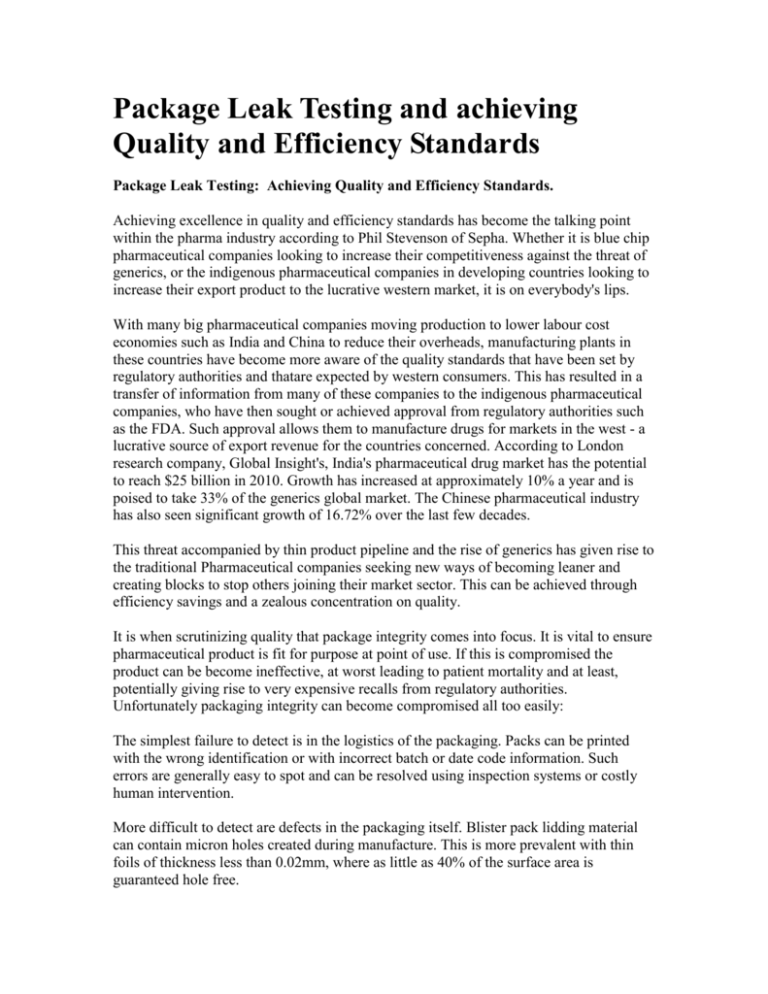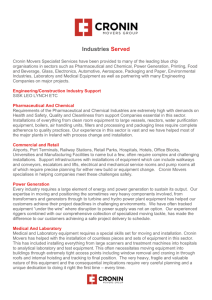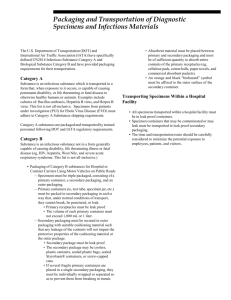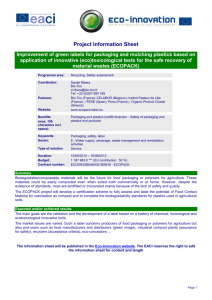Package Leak Testing and achieving Quality and Efficiency Standards
advertisement

Package Leak Testing and achieving Quality and Efficiency Standards Package Leak Testing: Achieving Quality and Efficiency Standards. Achieving excellence in quality and efficiency standards has become the talking point within the pharma industry according to Phil Stevenson of Sepha. Whether it is blue chip pharmaceutical companies looking to increase their competitiveness against the threat of generics, or the indigenous pharmaceutical companies in developing countries looking to increase their export product to the lucrative western market, it is on everybody's lips. With many big pharmaceutical companies moving production to lower labour cost economies such as India and China to reduce their overheads, manufacturing plants in these countries have become more aware of the quality standards that have been set by regulatory authorities and thatare expected by western consumers. This has resulted in a transfer of information from many of these companies to the indigenous pharmaceutical companies, who have then sought or achieved approval from regulatory authorities such as the FDA. Such approval allows them to manufacture drugs for markets in the west - a lucrative source of export revenue for the countries concerned. According to London research company, Global Insight's, India's pharmaceutical drug market has the potential to reach $25 billion in 2010. Growth has increased at approximately 10% a year and is poised to take 33% of the generics global market. The Chinese pharmaceutical industry has also seen significant growth of 16.72% over the last few decades. This threat accompanied by thin product pipeline and the rise of generics has given rise to the traditional Pharmaceutical companies seeking new ways of becoming leaner and creating blocks to stop others joining their market sector. This can be achieved through efficiency savings and a zealous concentration on quality. It is when scrutinizing quality that package integrity comes into focus. It is vital to ensure pharmaceutical product is fit for purpose at point of use. If this is compromised the product can be become ineffective, at worst leading to patient mortality and at least, potentially giving rise to very expensive recalls from regulatory authorities. Unfortunately packaging integrity can become compromised all too easily: The simplest failure to detect is in the logistics of the packaging. Packs can be printed with the wrong identification or with incorrect batch or date code information. Such errors are generally easy to spot and can be resolved using inspection systems or costly human intervention. More difficult to detect are defects in the packaging itself. Blister pack lidding material can contain micron holes created during manufacture. This is more prevalent with thin foils of thickness less than 0.02mm, where as little as 40% of the surface area is guaranteed hole free. Even if the lidding material could be guaranteed at point of supply, damage can occur during set up or as a result of tool damage on the packing line itself. According to Charles Barker, Chief Technical Officer of Sepha, holes as small as 10um can cause deterioration in product sensitive to moisture or atmospheric gasses can contaminate product whenever hole sizes reach 50um or more. These cases can lead to substantial reduction in product shelf life. Producers of oncology drugs have expressed concern that chemical substances from compromised packaged drugs could be dangerous to operators handling the drugs from production line to patient. Given that holes less than 50um in packaged product are generally undetectable to the human eye a method of testing is required. Methylene Blue dye test The time honoured and by far the most popular method of leak testing packaged product is the infamous Methylene Blue Dye test. A messy, destructive and subjective test that really does not befit the technical excellence associated with modern pharmaceutical manufacturing. Yes, when appropriately set up this method can identify holes as small as 10 microns, but the subjective nature of the test and variance in set-up across packaging lines can lead to validation issues. This combined with the needless destruction of good packs and the intensive reliance on the operator lead Sepha to believe that the time has now come to replace this method with a more suitable alternative. Research carried out by Sepha has revealed that the top Pharmaceutical manufacturers are focussing their efforts on improving efficiencies and reducing labour costs throughout their production line. In this respect, the blue dye test and other destructive methods of leak testing are wholly unsatisfactory, as they are operator-intensive, time consuming and messy. "Do manufacturers driven by clean really want buckets of liquid dye next to their packaging line?" One of the attractions of the blue dye test is the low cost of the equipment required. In it's basic form this consists of a vacuum pump, bucket, coloured liquid and a stopwatch. At first glance this may look very attractive, but the real cost of running the Blue Dye Test is seen only when the cost of disposing the waste (financial and environmental) and lost production is considered. For example one packaging line producing 14 tablet blisters running two 8 hour shifts would waste $4480 per day based on the tablets costing 1$ each and 10 packs being tested every half an hour. This cost is before disposal of tested product is even considered. Sepha identified the need to develop a leak test for packaging that would not compromise the product or the packaging. When subjected to a reduction in pressure flexible packaging will move. This can be observed in the change in packaging shape or the force exerted by the packaging on an adjacent body. In these cases if a large (gross) hole exists the packaged atmosphere will be quickly drawn out under vacuum and little change in packaging shape will be observed. Where small holes exist there will be an immediate change in the packaging but over time, as the trapped atmosphere leaks out, the package reverts back to its original shape. These changes, or lack of changes, Sepha has used to develop a number of nondestructive leak tests. For sachets and pouches Sepha has developed the PakScan, a machine that tests multiple packs using load cells to measure the force generated by the packaging under vacuum. Sepha machines are designed to isolate this force, measuring peak force and rate of change to establish presence of both large and small holes down to 10 micron. While effective for sachets and pouches, Sepha believes that force measurement is ineffective for blister packs, which require multiple load cells for a single pack constraining machine capacity, flexibility and ease of calibration. More effective for blisters are methods, which utilise cameras or high accuracy laser measurement to monitor deflection of the lidding foil. Sepha's BlisterScan utilizes a single laser to move across the blister pockets measuring their deflection and enhances these changes by altering the pressure levels during testing. This system allows multiple packs to be tested in a single test best mirroring the blue dye test methodology. Laser technology scanning pockets to determine those with large and small holes Both the BlisterScan and PakScan provide a fully validatable alternative to the Methylene Blue Dye test. Along with the cost benefits these machines provide they also produce useful batch data that can be used by manufacturers to monitor their performance and improve their line efficiencies. As a result these state of the art machines have been chosen by leading global pharmaceutical manufacturers in their pursuit of excellence in the areas of quality and efficiency. Every pharmaceutical manufacturer is faced with the challenge of competing in an ever increasing market place in which quality assurance is paramount and in an economy that requires organisations to continually cut costs. When analysing quality and efficiencies on their production line, manufacturers must come to a decision on leak testing packaging. As demonstrated above, Sepha believes that the subjective and wasteful Methylene Blue Dye test has too many limitations to be acceptable in the current market. With other non-destructive means of testing available, there is no longer any need to rely on such a primitive and subjective form of testing. For up and coming pharmaceutical companies seeking regulatory approval, non-destructive leak testing machines provides a means of proving quality standards and shows a commitment to maintain and ever improve their quality standards. Blister packaging, sachet and pouch packaging are widely used throughout the pharmaceutical industry for the excellent product protection it provides; therefore it is essential that the means of testing this packaging doesn't undermine this. Now is the time to reduce wastage and increase confidence in package leak testing.








